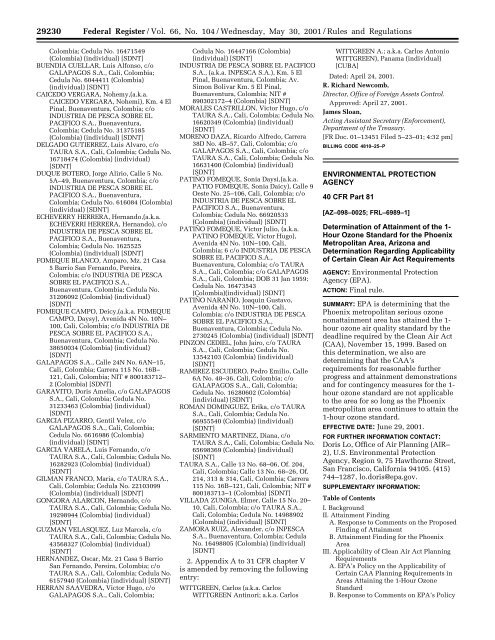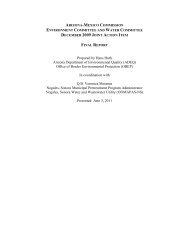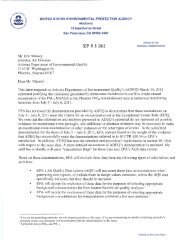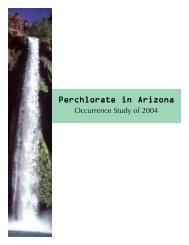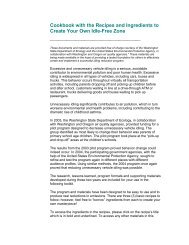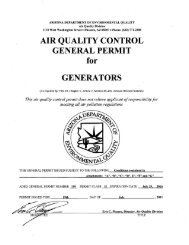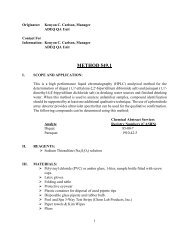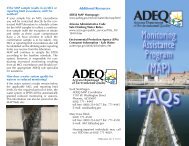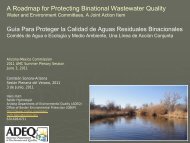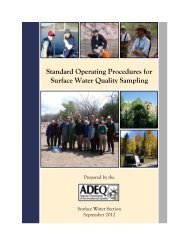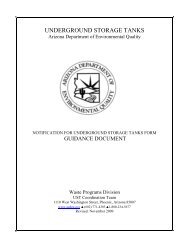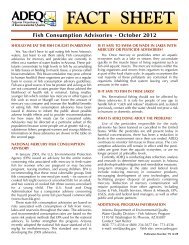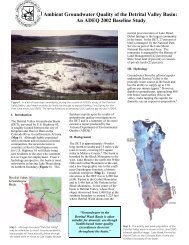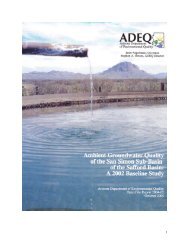66 FR 29230 - Determination of Attainment of the - U.S. Government ...
66 FR 29230 - Determination of Attainment of the - U.S. Government ...
66 FR 29230 - Determination of Attainment of the - U.S. Government ...
- No tags were found...
You also want an ePaper? Increase the reach of your titles
YUMPU automatically turns print PDFs into web optimized ePapers that Google loves.
<strong>29230</strong> Federal Register / Vol. <strong>66</strong>, No. 104 / Wednesday, May 30, 2001 / Rules and RegulationsColombia; Cedula No. 16471549(Colombia) (individual) [SDNT]BUENDIA CUELLAR, Luis Alfonso, c/oGALAPAGOS S.A., Cali, Colombia;Cedula No. 6044411 (Colombia)(individual) [SDNT]CAICEDO VERGARA, Nohemy,(a.k.a.CAICEDO VERGARA, Nohemi), Km. 4 ElPinal, Buenaventura, Colombia; c/oINDUSTRIA DE PESCA SOBRE ELPACIFICO S.A., Buenaventura,Colombia; Cedula No. 31375185(Colombia) (individual) [SDNT]DELGADO GUTIERREZ, Luis Alvaro, c/oTAURA S.A., Cali, Colombia; Cedula No.16718474 (Colombia) (individual)[SDNT]DUQUE BOTERO, Jorge Alirio, Calle 5 No.5A–49, Buenaventura, Colombia; c/oINDUSTRIA DE PESCA SOBRE ELPACIFICO S.A., Buenaventura,Colombia; Cedula No. 616084 (Colombia)(individual) [SDNT]ECHEVERRY HERRERA, Hernando,(a.k.a.ECHEVERRI HERRERA, Hernando), c/oINDUSTRIA DE PESCA SOBRE ELPACIFICO S.A., Buenaventura,Colombia; Cedula No. 1625525(Colombia) (individual) [SDNT]FOMEQUE BLANCO, Amparo, Mz. 21 Casa5 Barrio San Fernando, Pereira,Colombia; c/o INDUSTRIA DE PESCASOBRE EL PACIFICO S.A.,Buenaventura, Colombia; Cedula No.31206092 (Colombia) (individual)[SDNT]FOMEQUE CAMPO, Deicy,(a.k.a. FOMEQUECAMPO, Daysy), Avenida 4N No. 10N–100, Cali, Colombia; c/o INDUSTRIA DEPESCA SOBRE EL PACIFICO S.A.,Buenaventura, Colombia; Cedula No.38650034 (Colombia) (individual)[SDNT]GALAPAGOS S.A., Calle 24N No. 6AN–15,Cali, Colombia; Carrera 115 No. 16B–121, Cali, Colombia; NIT # 800183712–2 (Colombia) [SDNT]GARAVITO, Doris Amelia, c/o GALAPAGOSS.A., Cali, Colombia; Cedula No.31233463 (Colombia) (individual)[SDNT]GARCIA PIZARRO, Gentil Velez, c/oGALAPAGOS S.A., Cali, Colombia;Cedula No. <strong>66</strong>16986 (Colombia)(individual) [SDNT]GARCIA VARELA, Luis Fernando, c/oTAURA S.A., Cali, Colombia; Cedula No.16282923 (Colombia) (individual)[SDNT]GILMAN <strong>FR</strong>ANCO, Maria, c/o TAURA S.A.,Cali, Colombia; Cedula No. 22103099(Colombia) (individual) [SDNT]GONGORA ALARCON, Hernando, c/oTAURA S.A., Cali, Colombia; Cedula No.19298944 (Colombia) (individual)[SDNT]GUZMAN VELASQUEZ, Luz Marcela, c/oTAURA S.A., Cali, Colombia; Cedula No.43568327 (Colombia) (individual)[SDNT]HERNANDEZ, Oscar, Mz. 21 Casa 5 BarrioSan Fernando, Pereira, Colombia; c/oTAURA S.A., Cali, Colombia; Cedula No.6157940 (Colombia) (individual) [SDNT]HERRAN SAAVEDRA, Victor Hugo, c/oGALAPAGOS S.A., Cali, Colombia;Cedula No. 164471<strong>66</strong> (Colombia)(individual) [SDNT]INDUSTRIA DE PESCA SOBRE EL PACIFICOS.A., (a.k.a. INPESCA S.A.), Km. 5 ElPinal, Buenaventura, Colombia; Av.Simon Bolivar Km. 5 El Pinal,Buenaventura, Colombia; NIT #890302172–4 (Colombia) [SDNT]MORALES CASTRILLON, Victor Hugo, c/oTAURA S.A., Cali, Colombia; Cedula No.1<strong>66</strong>20349 (Colombia) (individual)[SDNT]MORENO DAZA, Ricardo Alfredo, Carrera38D No. 4B–57, Cali, Colombia; c/oGALAPAGOS S.A., Cali, Colombia; c/oTAURA S.A., Cali, Colombia; Cedula No.1<strong>66</strong>31400 (Colombia) (individual)[SDNT]PATIÑO FOMEQUE, Sonia Daysi,(a.k.a.PATIO FOMEQUE, Sonia Daicy), Calle 9Oeste No. 25–106, Cali, Colombia; c/oINDUSTRIA DE PESCA SOBRE ELPACIFICO S.A., Buenaventura,Colombia; Cedula No. <strong>66</strong>920533(Colombia) (individual) [SDNT]PATIÑO FOMEQUE, Victor Julio, (a.k.a.PATINO FOMEQUE, Victor Hugo),Avenida 4N No. 10N–100, Cali,Colombia; 6 c/o INDUSTRIA DE PESCASOBRE EL PACIFICO S.A.,Buenaventura, Colombia; c/o TAURAS.A., Cali, Colombia; c/o GALAPAGOSS.A., Cali, Colombia; DOB 31 Jan 1959;Cedula No. 16473543(Colombia)(individual) [SDNT]PATIÑO NARANJO, Joaquin Gustavo,Avenida 4N No. 10N–100, Cali,Colombia; c/o INDUSTRIA DE PESCASOBRE EL PACIFICO S.A.,Buenaventura, Colombia; Cedula No.2730245 (Colombia) (individual) [SDNT]PINZON CEDIEL, John Jairo, c/o TAURAS.A., Cali, Colombia; Cedula No.13542103 (Colombia) (individual)[SDNT]RAMIREZ ESCUDERO, Pedro Emilio, Calle6A No. 48–36, Cali, Colombia; c/oGALAPAGOS S.A., Cali, Colombia;Cedula No. 16280602 (Colombia)(individual) [SDNT]ROMAN DOMINGUEZ, Erika, c/o TAURAS.A., Cali, Colombia; Cedula No.<strong>66</strong>955540 (Colombia) (individual)[SDNT]SARMIENTO MARTINEZ, Diana, c/oTAURA S.A., Cali, Colombia; Cedula No.65698369 (Colombia) (individual)[SDNT]TAURA S.A., Calle 13 No. 68–06, Of. 204,Cali, Colombia; Calle 13 No. 68–26, Of.214, 313 & 314, Cali, Colombia; Carrera115 No. 16B–121, Cali, Colombia; NIT #800183713–1 (Colombia) [SDNT]VILLADA ZUNIGA, Elmer, Calle 15 No. 20–10, Cali, Colombia; c/o TAURA S.A.,Cali, Colombia; Cedula No. 14988902(Colombia) (individual) [SDNT]ZAMORA RUIZ, Alexander, c/o INPESCAS.A., Buenaventura, Colombia; CedulaNo. 16498805 (Colombia) (individual)[SDNT]2. Appendix A to 31 C<strong>FR</strong> chapter Vis amended by removing <strong>the</strong> followingentry:WITTGREEN, Carlos (a.k.a. CarlosWITTGREEN Antinori; a.k.a. CarlosWITTGREEN A.; a.k.a. Carlos AntonioWITTGREEN), Panama (individual)[CUBA]Dated: April 24, 2001.R. Richard Newcomb,Director, Office <strong>of</strong> Foreign Assets Control.Approved: April 27, 2001.James Sloan,Acting Assistant Secretary (Enforcement),Department <strong>of</strong> <strong>the</strong> Treasury.[<strong>FR</strong> Doc. 01–13451 Filed 5–23–01; 4:32 pm]BILLING CODE 4810–25–PENVIRONMENTAL PROTECTIONAGENCY40 C<strong>FR</strong> Part 81[AZ–098–0025; <strong>FR</strong>L–6989–1]<strong>Determination</strong> <strong>of</strong> <strong>Attainment</strong> <strong>of</strong> <strong>the</strong> 1-Hour Ozone Standard for <strong>the</strong> PhoenixMetropolitan Area, Arizona and<strong>Determination</strong> Regarding Applicability<strong>of</strong> Certain Clean Air Act RequirementsAGENCY: Environmental ProtectionAgency (EPA).ACTION: Final rule.SUMMARY: EPA is determining that <strong>the</strong>Phoenix metropolitan serious ozonenonattainment area has attained <strong>the</strong> 1-hour ozone air quality standard by <strong>the</strong>deadline required by <strong>the</strong> Clean Air Act(CAA), November 15, 1999. Based onthis determination, we also aredetermining that <strong>the</strong> CAA’srequirements for reasonable fur<strong>the</strong>rprogress and attainment demonstrationsand for contingency measures for <strong>the</strong> 1-hour ozone standard are not applicableto <strong>the</strong> area for so long as <strong>the</strong> Phoenixmetropolitan area continues to attain <strong>the</strong>1-hour ozone standard.EFFECTIVE DATE: June 29, 2001.FOR FURTHER INFORMATION CONTACT:Doris Lo, Office <strong>of</strong> Air Planning (AIR–2), U.S. Environmental ProtectionAgency, Region 9, 75 Hawthorne Street,San Francisco, California 94105. (415)744–1287, lo.doris@epa.gov.SUPPLEMENTARY INFORMATION:Table <strong>of</strong> ContentsI. BackgroundII. <strong>Attainment</strong> FindingA. Response to Comments on <strong>the</strong> ProposedFinding <strong>of</strong> <strong>Attainment</strong>B. <strong>Attainment</strong> Finding for <strong>the</strong> PhoenixAreaIII. Applicability <strong>of</strong> Clean Air Act PlanningRequirementsA. EPA’s Policy on <strong>the</strong> Applicability <strong>of</strong>Certain CAA Planning Requirements inAreas Attaining <strong>the</strong> 1-Hour OzoneStandardB. Response to Comments on EPA’s PolicyVerDate 112000 14:35 May 29, 2001 Jkt 194001 PO 00000 Frm 00016 Fmt 4700 Sfmt 4700 E:\<strong>FR</strong>\FM\30MYR1.SGM pfrm06 PsN: 30MYR1
Federal Register / Vol. <strong>66</strong>, No. 104 / Wednesday, May 30, 2001 / Rules and Regulations29231C. Effects <strong>of</strong> <strong>the</strong> <strong>Determination</strong> on <strong>the</strong>Phoenix Area and <strong>of</strong> a Future Violationon this <strong>Determination</strong>D. Effect <strong>of</strong> <strong>the</strong> <strong>Determination</strong> onTransportation ConformityIV. Administrative RequirementsI. BackgroundUnder CAA section 181(b)(2)(A), wemust determine within six months <strong>of</strong> anarea’s applicable attainment datewhe<strong>the</strong>r an ozone nonattainment areahas attained <strong>the</strong> 1-hour ozone standard.On May 19, 2000 (65 <strong>FR</strong> 31859), weproposed to find that <strong>the</strong> Phoenixmetropolitan serious ozonenonattainment area had attained <strong>the</strong> 1-hour ozone standard by its Clean AirAct (CAA) mandated attainment date <strong>of</strong>November 15, 1999. This proposal wasbased on all available, quality-assuredair quality data collected from <strong>the</strong>monitoring network, which wedetermined met our regulations for stateair quality monitoring networks.II. <strong>Attainment</strong> FindingA. Response to Comments on <strong>the</strong>Proposed Finding <strong>of</strong> <strong>Attainment</strong>We received comments on ourproposed attainment finding only from<strong>the</strong> Arizona Center for Law in <strong>the</strong> PublicInterest (ACLPI). These commentsconcerned <strong>the</strong> adequacy <strong>of</strong> <strong>the</strong> Phoenixarea ozone monitoring network. Werespond to <strong>the</strong> most important <strong>of</strong> <strong>the</strong>secomments below. Our completeresponses to all comments can be foundin <strong>the</strong> technical support document(TSD) for this action.Comment: ACLPI claims that EPA’sproposed rulemaking contains noevidence that Maricopa CountyEnvironmental Services Department(MCESD) has made changes to its ozonenetwork in response to <strong>the</strong> inadequaciesdocumented by EPA in <strong>the</strong> past. It alsoasserts that <strong>the</strong> County and <strong>the</strong> Statehave apparently discontinued <strong>the</strong> use <strong>of</strong>certain monitoring sites and states itfound particularly troubling <strong>the</strong>discontinuance <strong>of</strong> <strong>the</strong> Papago Parkmonitor, which recorded <strong>the</strong> highestozone violation in 1995.Response: We agree that <strong>the</strong> MaricopaCounty ozone monitoring network wasdeficient when evaluated by EPA in1989 and 1992. However, ra<strong>the</strong>r thanreviewing all <strong>of</strong> <strong>the</strong> past inadequaciesand determining whe<strong>the</strong>r <strong>the</strong> Countyaddressed each one, we decided that amore reasonable approach was toevaluate <strong>the</strong> ozone monitoring networkoperated by MCESD as it existed during<strong>the</strong> attainment period 1997–1999. Wehave worked successfully with <strong>the</strong>MCESD over <strong>the</strong> past 9 years to improveits ambient monitoring program. Wehave determined that <strong>the</strong> ozonemonitoring network as designed andoperated during <strong>the</strong> attainment period,and at present, meets all applicablefederal regulations. By concluding that<strong>the</strong> network meets our monitoringregulations, we effectively concludedthat MCESD has corrected all pastinadequacies.The issue <strong>of</strong> whe<strong>the</strong>r or not <strong>the</strong>County and/or State has discontinued<strong>the</strong> operation <strong>of</strong> certain sites is not asimportant as whe<strong>the</strong>r <strong>the</strong> remainingnetwork is designed and operated in amanner that allows <strong>the</strong> determinationthat <strong>the</strong> data collected are representative<strong>of</strong> ozone air quality in <strong>the</strong> Phoenix area.We have concluded that <strong>the</strong> network issufficient to serve that purpose.The Papago Park ozone monitor isstill operating but has been renamed‘‘Emergency Management.’’ Papago Parkwas <strong>the</strong> name given to <strong>the</strong> site by <strong>the</strong>Arizona Department <strong>of</strong> EnvironmentalQuality (ADEQ) which initially operated<strong>the</strong> site. When <strong>the</strong> County took over <strong>the</strong>site, it was renamed EmergencyManagement. The site has been incontinuous operation since it wasestablished in 1990.Comment: ACLPI asserts that EPAacknowledged that <strong>the</strong> ozone network inPhoenix still fails to meet all <strong>of</strong> <strong>the</strong>design requirements <strong>of</strong> 40 C<strong>FR</strong> part 58in that <strong>the</strong> network does not meet <strong>the</strong>third monitoring objective,‘‘determining <strong>the</strong> impact on ambientpollution levels <strong>of</strong> significant sources orsource categories,’’ which can be met bymonitoring emissions from significantsources <strong>of</strong> nitrogen oxides (NO X ) andvolatile organic compounds (VOC).Response: We stand by our positionthat in designing an ozone monitoringnetwork—that is, a monitoring networkthat measures <strong>the</strong> concentration <strong>of</strong> <strong>the</strong>chemical compound ‘‘ozone’’ (O 3 )—anagency cannot meet <strong>the</strong> thirdmonitoring objective <strong>of</strong> assessing <strong>the</strong>impact <strong>of</strong> major sources or sourcecategories since ozone is not emitted byany type <strong>of</strong> source. Ozone is formed inan atmospheric, photochemical reactionbetween NO X and VOC. Precursoremissions from a source are transportedwell downwind before <strong>the</strong>y react t<strong>of</strong>orm ozone. In an urban setting,emissions from large point sources mixwith emissions from area and mobilesources as <strong>the</strong>y are transporteddownwind and form ozone. In thissetting, it is impossible to monitorspecifically for ozone formed from asingle source’s precursor emissions.For areas designated as transitional,marginal, and/or moderate ozonenonattainment areas, <strong>the</strong>re is norequirement to monitor for <strong>the</strong> chemicalprecursors <strong>of</strong> ozone. Once an area isdesignated or reclassified to serious orabove, <strong>the</strong> state is required to institutea photochemical assessment monitoring(PAMS) program under CAA section182(c)(1) and its implementingregulations. PAMS programs require <strong>the</strong>seasonal monitoring <strong>of</strong> VOC and NO X atcertain locations in urbannonattainment areas such as downwind<strong>of</strong> <strong>the</strong> area’s central business district(type 2 site) and in <strong>the</strong> downwindarea(s) where maximum ozoneconcentrations are expected to occur(type 3 site).When we reclassified <strong>the</strong> Phoenixarea as serious in 1997, <strong>the</strong> design anddeployment <strong>of</strong> a PAMS network becamea requirement for <strong>the</strong> area. ADEQ hasbegun <strong>the</strong> implementation <strong>of</strong> <strong>the</strong> area’sPAMS network and has deployed a type2 site and is in <strong>the</strong> process <strong>of</strong> installinga type 3 site at this time. ADEQ’simplementation schedule is generallyconsistent with our PAMS regulations.These sites are appropriately located tomeet <strong>the</strong> PAMS siting requirements. Therequirement for operating a PAMSnetwork remains even though we aremaking a finding that <strong>the</strong> Phoenix areahas attained <strong>the</strong> 1-hour ozone NAAQS.Data from <strong>the</strong> PAMS network, however,are not and cannot be used in makinga determination <strong>of</strong> whe<strong>the</strong>r or not anarea has met <strong>the</strong> ozone NAAQS because<strong>the</strong> network only monitors for ozoneprecursors and not for ozone itself.Comment: ACLPI asserts thatMaricopa County’s monitoring networkis inadequate because <strong>the</strong> County failsto operate all <strong>of</strong> its SLAMS sites yearround,stating that EPA regulationsrequire states to monitor ozone atNAMS and SLAMS sites throughout <strong>the</strong>ozone season and that <strong>the</strong> ozone seasonin Arizona runs from January throughDecember citing 40 C<strong>FR</strong> part 58,appendix D. ACLPI also claims thatdespite <strong>the</strong>se regulations, more than half<strong>of</strong> <strong>the</strong> County’s SLAMS sites operateonly between April 1 and October 31.While exceedances <strong>of</strong> <strong>the</strong> 1-hour ozonestandard may be rare during <strong>the</strong> wintermonths, <strong>the</strong>y can occur. Consequently,<strong>the</strong>re is no assurance that <strong>the</strong>seexceedances would be captured by one<strong>of</strong> <strong>the</strong> annually operating sites due towide spatial and temporal differences inozone concentrations.Response: We disagree with ACLPI’sassertion that <strong>the</strong> ozone monitoringnetwork is inadequate because a portion<strong>of</strong> <strong>the</strong> monitoring sites operates on aseasonal basis. Our regulations at 40C<strong>FR</strong> 58.25 allow states to makemodifications to <strong>the</strong>ir SLAMS networkwith <strong>the</strong> approval <strong>of</strong> EPA. The Countymade this modification to its operatingschedule with <strong>the</strong> full concurrence <strong>of</strong>EPA Region 9 (see letter to Ben Davis,Air Quality AIRS Program Coordinator,VerDate 112000 14:35 May 29, 2001 Jkt 194001 PO 00000 Frm 00017 Fmt 4700 Sfmt 4700 E:\<strong>FR</strong>\FM\30MYR1.SGM pfrm06 PsN: 30MYR1
29232 Federal Register / Vol. <strong>66</strong>, No. 104 / Wednesday, May 30, 2001 / Rules and RegulationsMCESD, from John R. Kennedy, Chief,Technical Support Office, Air Division,U.S. EPA Region 9, November 2, 1999).Moreover, we believe that <strong>the</strong>monitoring network, even with <strong>the</strong>seasonal monitors shut down, stillprovides for adequate spatial coverage<strong>of</strong> <strong>the</strong> Phoenix nonattainment areaduring <strong>the</strong> winter months. During <strong>the</strong>five months (November through March)<strong>the</strong> County shuts down eight sites—lessthan half <strong>of</strong> <strong>the</strong> ozone monitoringsites—leaving functional <strong>the</strong> remainingozone network <strong>of</strong> ten sites operated by<strong>the</strong> County as well as a number <strong>of</strong>special purpose monitoring sitesoperated by ADEQ. The sites that areoperated seasonally are generally <strong>the</strong>sites recording <strong>the</strong> lowest ozoneconcentrations.Regarding <strong>the</strong> possibility <strong>of</strong>exceedances <strong>of</strong> <strong>the</strong> 1-hour ozonestandard during <strong>the</strong> November to Marchperiod, we have reviewed ozone data for<strong>the</strong> Phoenix area during <strong>the</strong> period 1980through 1999. In <strong>the</strong>se 19 years, <strong>the</strong>Phoenix area has had only oneexceedance in <strong>the</strong> month <strong>of</strong> April, threein <strong>the</strong> month <strong>of</strong> October, and none in<strong>the</strong> months <strong>of</strong> November, December,January, February and March. The vastmajority <strong>of</strong> ozone exceedances in <strong>the</strong>Phoenix area occur in <strong>the</strong> months <strong>of</strong>June, July, August, and September when<strong>the</strong> full network is in operation.We do agree with ACLPI’s statementthat ozone air monitoring serves o<strong>the</strong>rpurposes besides recordingexceedances. We believe that portion <strong>of</strong><strong>the</strong> network that operates year roundprovides adequate data for any o<strong>the</strong>rassessment purpose.B. <strong>Attainment</strong> Finding for <strong>the</strong> PhoenixAreaThe 1-hour ozone NAAQS is 0.12parts per million (ppm) not to beexceeded on average more than one dayper year over any three-year period. 40C<strong>FR</strong> 50.9 and appendix H. Wedetermine if an area has attained <strong>the</strong> 1-hour standard by calculating, at eachmonitor, <strong>the</strong> average number <strong>of</strong> daysover <strong>the</strong> standard per year during <strong>the</strong>preceding three-year period. 1 We use allavailable, quality assured monitoringdata. Under CAA section 181(b)(2)(A),1 See generally 57 <strong>FR</strong> 13506 (April 16, 1992) andMemorandum from D. Kent Berry, Acting Director,Air Quality Management Division, EPA, to RegionalAir Office Directors; ‘‘Procedures for ProcessingBump Ups and Extensions for Marginal OzoneNonattainment Areas,’’ February 3, 1994 (Berrymemorandum). While explicitly applicable only tomarginal areas, <strong>the</strong> general procedures forevaluating attainment in this memorandum apply to<strong>the</strong> Phoenix area in spite <strong>of</strong> its serious classificationbecause <strong>the</strong> finding <strong>of</strong> attainment is being madepursuant to <strong>the</strong> same Clean Air Act requirementsin section 181(b)(2).we must base our determination <strong>of</strong>attainment or failure to attain on <strong>the</strong>area’s design value as <strong>of</strong> its applicableattainment deadline, which for <strong>the</strong>Phoenix metropolitan area wasNovember 15, 1999. (See section III.C.for a discussion <strong>of</strong> air quality data afterNovember 15, 1999 and consequences <strong>of</strong>future violations.)The design value for <strong>the</strong> Phoenixmetropolitan ozone nonattainment areafor <strong>the</strong> 1997 to 1999 period was 0.113ppm. The Phoenix metropolitan areadid not record any exceedances <strong>of</strong> <strong>the</strong>1-hour ozone standard at anymonitoring site during <strong>the</strong> 1997 to 1999period, so <strong>the</strong> average number <strong>of</strong> daysover <strong>the</strong> standard at each monitor in <strong>the</strong>area for that three-year period was zero.The complete documentation <strong>of</strong> <strong>the</strong>monitoring data and design valuecalculation can be found in <strong>the</strong> TSD.Because <strong>the</strong> area’s design value wasbelow <strong>the</strong> 0.12 ppm 1-hour ozonestandard and <strong>the</strong> area averaged less than1 exceedance per year at each monitorfor <strong>the</strong> 1997 to 1999 period, we find that<strong>the</strong> Phoenix metropolitan area attained<strong>the</strong> 1-hour ozone standard by its CleanAir Act mandated attainment deadline<strong>of</strong> November 15, 1999.III. Applicability <strong>of</strong> Clean Air ActPlanning RequirementsA. EPA’s Policy on <strong>the</strong> Applicability <strong>of</strong>Certain CAA Planning Requirements inAreas Attaining <strong>the</strong> 1-Hour OzoneStandardCAA section 182(c) requires stateswith serious ozone nonattainment areasto comply with <strong>the</strong> Act’s serious areaSIP requirements. Three <strong>of</strong> <strong>the</strong>serequirements are tied to <strong>the</strong> attainmentdemonstration. They are as follows:1. A demonstration that this plan willresult in emission reductions <strong>of</strong> ozoneprecursors <strong>of</strong> at least 3 percent per yearfrom 1996 to 1999 (this provision isknown as <strong>the</strong> 9 percent rate <strong>of</strong> progress(ROP) plan), CAA section 182(c)(2)(B);2. A demonstration that <strong>the</strong> plan willresult in attainment <strong>of</strong> <strong>the</strong> 1-hour ozonestandard as expeditiously as practicablebut not later than November 15, 1999,CAA section 182(c)(2)(A);3. Contingency measures that will beundertaken if <strong>the</strong> area fails to makereasonable fur<strong>the</strong>r progress, meet a rate<strong>of</strong> progress milestone, or to attain <strong>the</strong>standard by <strong>the</strong> applicable attainmentdate, CAA sections 172(c)(9) and182(c)(9).We believe that it is reasonable tointerpret <strong>the</strong> CAA to not require <strong>the</strong>seprovisions for serious ozonenonattainment areas that are determinedto be meeting <strong>the</strong> 1-hour ozonestandard. We discuss our reasoning in<strong>the</strong> memorandum from John S. Seitz,Director, OAQPS, EPA, to Regional AirDirectors, entitled ‘‘Reasonable Fur<strong>the</strong>rProgress, <strong>Attainment</strong> Demonstrations,and Related Requirements for OzoneNonattainment Areas Meeting <strong>the</strong>Ozone National Ambient Air QualityStandard,’’ May 10, 1995 (Seitz memo),in <strong>the</strong> proposal for this action and belowin our response to comments. 2There are a number <strong>of</strong> o<strong>the</strong>r SIPrequirements for serious ozonenonattainment areas that are not tied towhe<strong>the</strong>r <strong>the</strong> area has attained <strong>the</strong> 1-hourstandard. These elements include anemission inventory <strong>of</strong> ozone precursors,reasonably available control technologyfor major sources and certain o<strong>the</strong>rsources; an enhanced motor vehicleinspection and maintenance program,and an enhanced ambient monitoringprogram. Arizona has already adoptedand submitted <strong>the</strong>se elements to us. 3B. Response to Comments on EPA’sPolicyACLPI also commented on <strong>the</strong>proposed determination regarding <strong>the</strong>applicability <strong>of</strong> certain CAA planningrequirements to <strong>the</strong> Phoenix area. Werespond to <strong>the</strong> most significant <strong>of</strong> <strong>the</strong>secomments below. Our full response toall comments can be found in <strong>the</strong> TSD.Comment: ACLPI claims that EPA hasillegally exempted <strong>the</strong> Phoenix areafrom <strong>the</strong> 9 percent rate <strong>of</strong> progress(ROP) 4 demonstration, attainmentdemonstration and contingency measurerequirements <strong>of</strong> <strong>the</strong> CAA. To supportthis contention, ACLPI makes twoarguments:(1) that, taken toge<strong>the</strong>r, sections172(c) and 182(c) require that a planrevision for a serious ozonenonattainment area include anattainment demonstration (sections172(c)(1) and 182(c)(2)(A)), a 9 percentROP demonstration (sections 172(c)(2)and 182(c)(2)(B)), and contingencymeasures (section 172(c)(9)); and(2) that <strong>the</strong> May 10, 1995 policymemorandum on which EPA relies to2 We have also explained at length in o<strong>the</strong>ractions our rationale for <strong>the</strong> reasonableness <strong>of</strong> thisinterpretation <strong>of</strong> <strong>the</strong> Act and incorporate thoseexplanations by reference here. See 61 <strong>FR</strong> 20458(May 7, 1996) (Cleveland-Akron-Lorrain, Ohio); 60<strong>FR</strong> 36723 (July 18, 1995) (Salt Lake and DavisCounties, Utah); 60 <strong>FR</strong> 373<strong>66</strong> (July 20, 1995) and61 <strong>FR</strong> 31832–33 (June 21, 1996) (Grand Rapids, MI).Our interpretation has also been upheld by <strong>the</strong>United States Court <strong>of</strong> Appeals for <strong>the</strong> 10th Circuitin Sierra Club v. EPA, 99 F.3d 1551 (10th Cir. 1996).3 Serious Area Ozone State Implementation Planfor Maricopa County; submitted to EPA by <strong>the</strong>Arizona Department <strong>of</strong> Environmental Quality onDecember 14, 2000,4 Although section 182(b)(1) (moderate areas) and(c)(2)(B) (serious areas) contain <strong>the</strong> term‘‘reasonable fur<strong>the</strong>r progress,’’ EPA <strong>of</strong>ten uses <strong>the</strong>terms ‘‘rate <strong>of</strong> progress’’ and ‘‘reasonable fur<strong>the</strong>rprogress’’ interchangeably.VerDate 112000 14:35 May 29, 2001 Jkt 194001 PO 00000 Frm 00018 Fmt 4700 Sfmt 4700 E:\<strong>FR</strong>\FM\30MYR1.SGM pfrm06 PsN: 30MYR1
Federal Register / Vol. <strong>66</strong>, No. 104 / Wednesday, May 30, 2001 / Rules and Regulations29233exempt <strong>the</strong> Phoenix area from <strong>the</strong>serequirements flatly contradicts <strong>the</strong> CAAin that <strong>the</strong> Act contains no exceptionsfrom its planning requirements for areasthat are potentially eligible forredesignation based on monitoring databut have not yet met <strong>the</strong> redesignationrequirements <strong>of</strong> sections 107(d)(3) and175A. ACLPI contends that undersection 175A <strong>of</strong> <strong>the</strong> Act until anonattainment area is redesignated anda maintenance plan is approved, <strong>the</strong>requirements <strong>of</strong> part D ‘‘shall continuein force and effect with respect to sucharea.’’ (ACLPI acknowledges that <strong>the</strong>United States Court <strong>of</strong> Appeals for <strong>the</strong>10th Circuit has upheld <strong>the</strong> May 10,1995 memorandum but states that <strong>the</strong>case was incorrectly decided.)Response: We proposed to find that<strong>the</strong>se Clean Air Act requirements arenot applicable to <strong>the</strong> Phoenix areabecause <strong>the</strong> area has attained <strong>the</strong> 1-hourozone standard as demonstrated bythree consecutive years without aviolation. In <strong>the</strong> proposal for today’saction, we discuss our determinationthat <strong>the</strong> Phoenix area attained <strong>the</strong> 1-hour ozone standard by its statutorydeadline <strong>of</strong> November 15, 1999. See 65<strong>FR</strong> 31859, 31861. This determination isdocumented in section II <strong>of</strong> <strong>the</strong> TSD.The statutory basis for finding that<strong>the</strong>se planning requirements are notapplicable is described in <strong>the</strong> proposaland in <strong>the</strong> Seitz memo. See 65 <strong>FR</strong>31859, 31861–31863; Seitz memo at 2–5.Contrary to ACLPI’s assertion, we arenot granting <strong>the</strong> Phoenix area anexemption from any applicablerequirements under part D. Ra<strong>the</strong>r, wehave interpreted <strong>the</strong> requirements <strong>of</strong>sections 182(c)(2)(A) and (B) and172(c)(9) as not being applicable oncean area has attained <strong>the</strong> standard, aslong as it continues to do so. (Seesection III.C. below.) This is not awaiver <strong>of</strong> requirements that by <strong>the</strong>irterms clearly apply; it is a determinationthat certain requirements are written soas to be operative only if <strong>the</strong> area is notattaining <strong>the</strong> standard. Ourinterpretation is consistent both with<strong>the</strong> CAA’s goal <strong>of</strong> achieving andmaintaining clean air, and with <strong>the</strong>concomitant policy goal <strong>of</strong> avoidingcostly and unnecessary emissionreductions.As discussed fur<strong>the</strong>r below, <strong>the</strong> plainlanguage <strong>of</strong> CAA sections 182(c)(2)(A)and (B) and 172(c)(9) does not clearlyrequire attainment, reasonable fur<strong>the</strong>rprogress or contingency measure plansfor areas that are designatednonattainment but that have alreadyattained, and continue to attain, <strong>the</strong>national ozone standard. However, <strong>the</strong>very purpose <strong>of</strong> <strong>the</strong>se plans is to bringareas that are violating <strong>the</strong> nationalambient air quality standard for ozoneinto attainment. Consistent with thispurpose, we interpret <strong>the</strong>serequirements as inapplicable to an areathat has attained <strong>the</strong> standard, but onlyfor so long as <strong>the</strong> area remains inattainment. The requirements will againapply if such an area violates <strong>the</strong>standard. Thus, our interpretation isstrictly limited to circumstances inwhich no fur<strong>the</strong>r emission reductionsare required for attainment.The language <strong>of</strong> CAA sections182(c)(2)(A) and (B) is ambiguous as towhe<strong>the</strong>r VOC reductions are requiredfor serious nonattainment areas thathave already attained <strong>the</strong> ozoneNAAQS, but that have not yet beenredesignated to attainment status. While<strong>the</strong> lead-in sentence to <strong>the</strong>se tworequirements states that ‘‘* * * <strong>the</strong>State shall submit a revision to <strong>the</strong>applicable implementation plan * * *,’’subsection (c)(2)(A) calls for ademonstration that <strong>the</strong> plan willprovide for attainment <strong>of</strong> <strong>the</strong> NAAQS‘‘by <strong>the</strong> applicable attainment date.’’Subsection (c)(2)(B) provides that <strong>the</strong> 9percent plan ‘‘will result in VOCemissions reductions * * * until <strong>the</strong>attainment date.’’ Thus, <strong>the</strong> language <strong>of</strong>sections 182(c)(2)(A) and (B) as a wholebegs <strong>the</strong> question <strong>of</strong> whe<strong>the</strong>r anyreductions are required for areas that arealready in attainment and <strong>the</strong>reforeneed no reductions in VOC emissions toachieve <strong>the</strong> ozone NAAQS by <strong>the</strong>attainment date.Section 182(c)(2)(B) is entitled‘‘Reasonable Fur<strong>the</strong>r Progressdemonstration.’’ The term ‘‘reasonablefur<strong>the</strong>r progress’’ is defined as ‘‘suchannual incremental reductions inemissions <strong>of</strong> <strong>the</strong> relevant air pollutant asare required by this part or mayreasonably be required by [EPA] for <strong>the</strong>purpose <strong>of</strong> ensuring attainment <strong>of</strong> <strong>the</strong>applicable [NAAQS] by <strong>the</strong> applicabledate.’’ CAA section 171(1). Thisdefinition applies for <strong>the</strong> purposes <strong>of</strong>part D <strong>of</strong> title I <strong>of</strong> <strong>the</strong> CAA, whichincludes section 182(c). Thus, <strong>the</strong> term‘‘reasonable fur<strong>the</strong>r progress’’ requiresonly such reductions in emissions as arenecessary to attain <strong>the</strong> NAAQS by <strong>the</strong>attainment date and no more.Accordingly, our interpretation <strong>of</strong>section 182(c)(2)(B) is consistent with<strong>the</strong> statutory definition <strong>of</strong> ‘‘reasonablefur<strong>the</strong>r progress.’’ Moreover, ourinterpretation is tightly bound to <strong>the</strong>purpose <strong>of</strong> section 182(c)(2)(B) becausewe interpret that section’s requirementsto be applicable to areas that lapse backinto violation prior to redesignation,and which <strong>the</strong>refore need additionalprogress towards attainment.Fur<strong>the</strong>rmore, our interpretation <strong>of</strong> <strong>the</strong>requirements <strong>of</strong> section 182(c)(2)(B) isconsistent with our interpretation <strong>of</strong> <strong>the</strong>general reasonable fur<strong>the</strong>r progressrequirements <strong>of</strong> CAA section 172. In <strong>the</strong>General Preamble interpreting certainprovisions <strong>of</strong> part I <strong>of</strong> <strong>the</strong> CAAAmendments <strong>of</strong> 1990, we explained that<strong>the</strong> reasonable fur<strong>the</strong>r progressrequirements <strong>of</strong> CAA section 172(c)(2)do not apply when ‘‘evaluating a requestfor redesignation to attainment, since, ata minimum, <strong>the</strong> air quality data for <strong>the</strong>area must show that <strong>the</strong> area has alreadyattained [<strong>the</strong> NAAQS] * * * [and] RFPtowards attainment will, <strong>the</strong>refore, haveno meaning at that point.’’ 57 <strong>FR</strong> at13564. This interpretation <strong>of</strong> <strong>the</strong>requirements <strong>of</strong> section 172(c) wasmade shortly after <strong>the</strong> CAAAmendments <strong>of</strong> 1990 and we haveconsistently adhered to thisinterpretation. See 60 <strong>FR</strong> at 30190(noting consistency <strong>of</strong> interpretation).As with <strong>the</strong> RFP requirement, if anarea has in fact monitored attainment <strong>of</strong><strong>the</strong> standard, we believe <strong>the</strong>re is noneed for an area to make a fur<strong>the</strong>rsubmission containing additionalmeasures to achieve attainment. Thus<strong>the</strong> attainment demonstrationrequirement in section 182(c)(2)(A)would no longer apply under <strong>the</strong>secircumstances. Seitz memo at 3.We likewise determined that section172(c)(9) does not require a contingencymeasure plan for nonattainment areas,such as Phoenix, which we determine tohave attained <strong>the</strong> standard prior toredesignation. The contingencymeasures plan is required for an areathat ‘‘fails to make reasonable fur<strong>the</strong>rprogress, or to attain <strong>the</strong> [NAAQS] by<strong>the</strong> attainment date * * *’’ If, as in <strong>the</strong>case <strong>of</strong> Phoenix, we determine that anarea has attained <strong>the</strong> standard by itsattainment date, <strong>the</strong>n by definition suchan area is not one to which contingencymeasures apply. There is simply n<strong>of</strong>ailure to attain by <strong>the</strong> attainment dateor make progress for which additionalmeasures need be contingent. However,as with sections 182(c)(2)(A) and (B), weinterpret section 172(c)(9)’srequirements to be applicable to areasthat lapse back into violation prior toredesignation, and that <strong>the</strong>refore needadditional progress towards attainment.Thus, our interpretation ensures that <strong>the</strong>purposes <strong>of</strong> section 172(c)(9)—toprovide for reasonable progress towards,and <strong>the</strong> attainment <strong>of</strong>, clean air—will beserved when necessary.We also do not agree with ACLPI’scontention that <strong>the</strong> Agency is violatingsection 175A(c) when it determines that<strong>the</strong> RFP, attainment and contingencymeasure requirements do not apply toareas that have attained <strong>the</strong> NAAQS.VerDate 112000 14:35 May 29, 2001 Jkt 194001 PO 00000 Frm 00019 Fmt 4700 Sfmt 4700 E:\<strong>FR</strong>\FM\30MYR1.SGM pfrm06 PsN: 30MYR1
29234 Federal Register / Vol. <strong>66</strong>, No. 104 / Wednesday, May 30, 2001 / Rules and RegulationsSection 175A(c) provides that <strong>the</strong>requirements <strong>of</strong> part D remain in forceand effect for an area until such time asit is redesignated. Section 175A(c) doesnot establish any additional substantiverequirements; ra<strong>the</strong>r, it ensures that <strong>the</strong>requirements that do apply by virtue <strong>of</strong>o<strong>the</strong>r Act provisions continue to applyuntil an area is redesignated. If,however, an Act provision does notapply to an area or does not require that<strong>the</strong> particular area in question submit aSIP revision, section 175A(c) does notsomehow add to <strong>the</strong> requirements withwhich <strong>the</strong> area must comply. In thisinstance, EPA is interpreting <strong>the</strong>underlying substantive requirements atissue so as not to apply to areas for solong as <strong>the</strong>y continue to attain <strong>the</strong>standard. This does not violate section175A(c); it is an interpretation <strong>of</strong> <strong>the</strong>substance <strong>of</strong> o<strong>the</strong>r provisions <strong>of</strong> <strong>the</strong> Act,a matter that is not affected by section175A(c). O<strong>the</strong>r requirements that do notdepend on whe<strong>the</strong>r <strong>the</strong> area has attained<strong>the</strong> standard, such as VOC RACTrequirements, continue to apply,however, and section 175A(c) ensuresthat <strong>the</strong>y continue to apply until <strong>the</strong>area is redesignated.Finally, in Sierra Club, <strong>the</strong> TenthCircuit Court <strong>of</strong> Appeals upheld <strong>the</strong>Seitz memo as it applies to moderateozone nonattainment areas. There,pending completion <strong>of</strong> <strong>the</strong> redesignationprocess, and based on three years <strong>of</strong> airquality data, EPA found that two UtahCounties that were designated asnonattainment for ozone and classifiedas moderate had attained <strong>the</strong> ozoneNAAQS. As a result, EPA determinedthat <strong>the</strong> CAA’s moderate arearequirements for attainment and RFPdemonstrations, and contingencymeasures (sections 182(b)(1)(A) and172(c)(9)) were inapplicable. Findingthat this determination was a logicalextension <strong>of</strong> EPA’s original, generalinterpretation in <strong>the</strong> General Preamble,<strong>the</strong> Court accorded deference to EPA’sinterpretation that once a moderateozone nonattainment area has attained<strong>the</strong> NAAQS, <strong>the</strong> moderate area CAArequirements for RFP, attainment andcontingency measures no longer apply.Id. at 1556. Although <strong>the</strong> Phoenix areais a serious nonattainment area, <strong>the</strong>re isno doubt that <strong>the</strong> analogous serious areaprovisions serve exactly <strong>the</strong> samepurpose as <strong>the</strong> provisions at issue inSierra Club for moderate areas. Thus <strong>the</strong>Court’s reasoning in that case appliesequally to <strong>the</strong> Phoenix situation.Comment: As stated above, ACLPIclaims that <strong>the</strong> Act specifically requiresthat until a nonattainment area isredesignated and a maintenance planapproved <strong>the</strong> requirements <strong>of</strong> part Dremain in force and effect with respectto such area, citing CAA section175A(c). ACLPI argues that ‘‘Congressdetermined that in <strong>the</strong> interest <strong>of</strong>protecting public health, EPA shouldnot be permitted to waivenonattainment planning requirementsuntil states could provide sufficientassurances that <strong>the</strong> NAAQS would bepermanently maintained’’ and that ‘‘it isnot <strong>the</strong> place <strong>of</strong> EPA to second guessthis policy determination.’’Response: The requirement that statesprovide sufficient assurances that <strong>the</strong>NAAQS will be permanentlymaintained is a criterion for <strong>the</strong>redesignation <strong>of</strong> an area to attainmentunder section 107(d)(3)(E) and not for afinding <strong>of</strong> attainment under section181(b)(1). We did not propose toredesignate <strong>the</strong> Phoenix area toattainment. Before we can do that,Arizona will need to provide, amongo<strong>the</strong>r things, sufficient assurances in <strong>the</strong>form <strong>of</strong> an adequate maintenance planthat <strong>the</strong> NAAQS will be ‘‘permanently’’maintained. As we have stated above weare not waiving <strong>the</strong>se requirements butare determining that by <strong>the</strong> language <strong>of</strong><strong>the</strong> CAA, <strong>the</strong>y do not apply.Comment: ACLPI also argues that<strong>the</strong>re is a sound public policy reason for<strong>the</strong> Act’s approach because a state’smonitored compliance with a NAAQSmay reflect only a temporaryimprovement in air quality due tounusually favorable meteorologicalconditions ra<strong>the</strong>r than ‘‘permanent andenforceable reductions in emissions’’ <strong>of</strong>a pollutant or pollutant precursors.Response: The requirement todetermine that clean air is <strong>the</strong> result <strong>of</strong>‘‘permanent and enforceable reductionsin emissions’’ is a criterion for <strong>the</strong>redesignation <strong>of</strong> an area to attainmentunder section 107(d)(3)(E) and not for afinding <strong>of</strong> attainment under section181(b)(1). We did not propose toredesignate <strong>the</strong> Phoenix area toattainment.That aside, we believe that <strong>the</strong> finding<strong>of</strong> attainment itself addresses in part <strong>the</strong>concern about unusually favorablemeteorological conditions. We havelong recognized that meteorologicalconditions have a pr<strong>of</strong>ound effect onambient ozone concentrations. In setting<strong>the</strong> current 1-hour ozone standard in1979, we changed <strong>the</strong> form <strong>of</strong> <strong>the</strong>standard, i.e., <strong>the</strong> criterion fordetermining attainment, from adeterministic form ‘‘no more than onceper year’’ to a statistical form ‘‘when <strong>the</strong>expected number <strong>of</strong> days per year is lessthan or equal to one’’ over a three-yearperiod in order to properly account for<strong>the</strong> random nature <strong>of</strong> meteorologicalvariations. The three-year period foraveraging <strong>the</strong> expected number <strong>of</strong>exceedances was a reasoned balancebetween evening out meteorologicaleffects and properly addressing realchanges in emission levels. See <strong>the</strong>proposal and final actions promulgating<strong>the</strong> current 1-hour ozone standard at 43<strong>FR</strong> 26962, 26968 (June 22, 1978) and 44<strong>FR</strong> 8202, 8218 (February 8, 1979).Moreover, <strong>the</strong> Phoenix area did notjust barely meet <strong>the</strong> 1-hour ozonestandard; it met <strong>the</strong> standard with roomto spare. An area can record up to threedays <strong>of</strong> air quality above <strong>the</strong> 1-hourozone standard at any one monitorduring a successive three-year periodand still be considered attaining <strong>the</strong>standard. The Phoenix area fared muchbetter than that, recording not a singleday over <strong>the</strong> standard at any <strong>of</strong> its 20ozone monitors from 1997 through1999. This record <strong>of</strong> clean air hascarried into a fourth year. During <strong>the</strong>2000 ozone season, <strong>the</strong> Phoenix areaagain did not record a single exceedance<strong>of</strong> <strong>the</strong> 1-hour ozone standard. See TSDat pp. 12–13. The area’s design value,which is a measure <strong>of</strong> <strong>the</strong> severity <strong>of</strong> anarea’s ozone problem and is used toestablish an area’s initial classification,was 10 percent below <strong>the</strong> standard anda 16 percent drop from its design valuefor <strong>the</strong> preceding three-year (1994–1996)period.Fur<strong>the</strong>rmore, under EPA’sredesignation guidance, <strong>the</strong>re are twoaspects to ‘‘permanent and enforceableemission reductions.’’ One is unusuallyfavorable meteorology. The o<strong>the</strong>r is atemporary reduction in emission ratescaused by shutdowns or reducedproduction due to temporary adverseeconomic conditions. SeeMemorandum, John Calcagni, Director,Air Quality Management Division(OAQPS), to Regional Air Directors,‘‘Procedures for Processing Requests toRedesignate Areas to <strong>Attainment</strong>,’’September 4, 1992, page 4. ‘‘Adverse’’ isnot a term that could be applied to <strong>the</strong>economy <strong>of</strong> <strong>the</strong> greater Phoenix areaover <strong>the</strong> last several years.In addition, we believe that <strong>the</strong>Phoenix area’s record <strong>of</strong> clean air can betied directly to permanent andenforceable emission reductions. Thearea is subject to a comprehensive ozonecontrol strategy that includes nationalon-road motor vehicle standards,national non-road engine standards,national consumer product standards,Arizona’s cleaner burning gasoline andvehicle emission inspection programs,and Maricopa County’s industrial andcommercial source rules. This strategyleaves few, if any, sources <strong>of</strong> VOCunregulated.Comment: ACLPI claims that EPAimplicitly recognizes <strong>the</strong> possibility that<strong>the</strong> Phoenix area may violate <strong>the</strong> ozoneNAAQS again. However, ACLPI statesVerDate 112000 14:35 May 29, 2001 Jkt 194001 PO 00000 Frm 00020 Fmt 4700 Sfmt 4700 E:\<strong>FR</strong>\FM\30MYR1.SGM pfrm06 PsN: 30MYR1
Federal Register / Vol. <strong>66</strong>, No. 104 / Wednesday, May 30, 2001 / Rules and Regulations29235that EPA <strong>the</strong>n dismisses this possibilitywith <strong>the</strong> observation that it can requirea SIP revision containing <strong>the</strong> missingelements if a violation occurs. ACLPIasserts that this approach will not help‘‘those who needlessly suffer fromunhealthy ozone levels that could havebeen avoided through compliance with<strong>the</strong> Act, noting that SIP revisions takemonths, sometimes years to complete.’’Finally, ACLPI contends that <strong>the</strong> ‘‘moreresponsible policy is <strong>the</strong> one adopted byCongress which requires states to adhereto <strong>the</strong> Act’s nonattainment planningrequirements until <strong>the</strong>y can demonstratethat redesignation <strong>of</strong> an area toattainment is warranted.’’Response: The Seitz memo explicitlyaddresses <strong>the</strong> consequences <strong>of</strong> futureviolations <strong>of</strong> <strong>the</strong> 1-hour ozone standard.In <strong>the</strong> proposal for today’s action, wemerely described this policy as it wouldapply to <strong>the</strong> Phoenix area if <strong>the</strong> areawere to violate <strong>the</strong> standard in <strong>the</strong>future. While this could be interpretedas acknowledging <strong>the</strong> possibility <strong>of</strong>future violations in <strong>the</strong> Phoenix area, itis not an acknowledgment <strong>of</strong> <strong>the</strong>probability <strong>of</strong> future violations.Fur<strong>the</strong>rmore, ozone will continue tobe controlled in <strong>the</strong> Phoenix area inspite <strong>of</strong> this finding <strong>of</strong> attainment and<strong>the</strong> concurrent finding that certain CAAplanning requirements no longer apply.As noted above, <strong>the</strong> State <strong>of</strong> Arizonaand <strong>the</strong> Maricopa CountyEnvironmental Services Department, <strong>the</strong>local air pollution control agency, haveadopted a comprehensive ozone controlprogram for <strong>the</strong> Phoenix area. All <strong>the</strong>seexisting ozone control measures remainin place and <strong>the</strong>se agencies remainobligated to fully implement andenforce <strong>the</strong>m. Most are SIP-approved orhave been submitted for SIP approval.See appendix A <strong>of</strong> <strong>the</strong> ‘‘Serious AreaOzone State Implementation Plan forMaricopa County,’’ submitted to EPA onDecember 14, 2000.In addition, <strong>the</strong> area will be <strong>the</strong>beneficiary <strong>of</strong> substantial new controlsover <strong>the</strong> next few years. The two largestsource categories <strong>of</strong> VOC emissions in<strong>the</strong> Phoenix area, in order, are gasolinepoweredon-road vehicles and gasolinepowerednon-road engines. Severalalready adopted state and federalmeasures will be implemented over <strong>the</strong>next few years that will fur<strong>the</strong>r reduceemissions from <strong>the</strong>se categories. Thesemeasures include Arizona’simplementation <strong>of</strong> <strong>the</strong> final, morestringent cut points for <strong>the</strong> VehicleEmissions Inspection Program (VEI) andexpansion <strong>of</strong> that program and <strong>the</strong>State’s Cleaner Burning Gas (CBG)program into growing areas thatsurround <strong>the</strong> core Phoenix urbanizedarea. Id.Nationally, we have issued our tier 2on-road motor vehicle standardscovering both light duty cars and lightduty trucks including sports utilityvehicles. 65 <strong>FR</strong> <strong>66</strong>97 (February 10,2000). For non-road engines, we haveestablished emission limitations for newnon-road engines <strong>of</strong> all types. Many <strong>of</strong><strong>the</strong>se standards have tiered emissionstandards that become increasinglystringent in future years. See, forexample, <strong>the</strong> tier 2 standards for smallgasoline-powered nonroad engines at 65<strong>FR</strong> 24267 (April 25, 2000).The Phoenix area will also benefitfrom national standards on <strong>the</strong> VOCcontent <strong>of</strong> consumer products requiredby CAA section 183(e). These standardscontrol <strong>the</strong> VOC content <strong>of</strong> suchconsumer products as paints, hairsprays, household pesticides, andmiscellaneous o<strong>the</strong>r consumer goods. 63<strong>FR</strong> 48819 (September 11, 1998). We alsocontinue to issue maximum availablecontrol technology (MACT) standardsunder CAA section 112(d) to reducehazardous air pollutants from stationarysources, most <strong>of</strong> which target VOCemissions. 40 C<strong>FR</strong> part 61.Finally, we note that under ACLPI’sconstruction <strong>of</strong> <strong>the</strong> CAA, <strong>the</strong> Phoenixarea would face <strong>the</strong> prospect <strong>of</strong>mandatory sanctions under CAA section179(a) for failing to submit <strong>the</strong> 9 percentreasonable fur<strong>the</strong>r progress, attainmentdemonstration, and contingencymeasures plans. For example, underACLPI’s interpretation <strong>of</strong> CAA section182(c)(2)(B), Arizona would have toadopt controls for <strong>the</strong> Phoenix area thatwould reduce VOC emissions by 9percent despite <strong>the</strong> fact that <strong>the</strong> area hasattained and continues to attain <strong>the</strong> 1-hour ozone NAAQS. These measureswould impose additional costs upon <strong>the</strong>area’s residents although <strong>the</strong>y areunnecessary for clean air. Thus, ACLPI’sinterpretation would not only requiremeasures that are not necessary forattaining <strong>the</strong> standard, it could also leadto sanctions for failing to submit <strong>the</strong>semeasures. EPA’s contrary interpretationwould not require unnecessary emissionreductions or sanctions for a state’sfailure to undertake such reductions.C. Effects <strong>of</strong> <strong>the</strong> <strong>Determination</strong> on <strong>the</strong>Phoenix Area and <strong>of</strong> a Future Violationon This <strong>Determination</strong>During <strong>the</strong> 2000 ozone season, <strong>the</strong>Phoenix area continued its record <strong>of</strong>clean air, experiencing no exceedances<strong>of</strong> <strong>the</strong> 1-hour ozone standard. In short,<strong>the</strong> area remains in attainment <strong>of</strong> <strong>the</strong> 1-hour ozone standard as <strong>of</strong> <strong>the</strong> date <strong>of</strong>this final action. Based on our findingthat <strong>the</strong> Phoenix metropolitan area isattaining <strong>the</strong> 1-hour ozone standard, weare finding that <strong>the</strong> State <strong>of</strong> Arizona isno longer required to submit a 9 percentROP plan, an attainment demonstration,or contingency measures for <strong>the</strong> area.The lack <strong>of</strong> a requirement to submit<strong>the</strong>se SIP revisions will exist only aslong as <strong>the</strong> Phoenix metropolitan areacontinues to attain <strong>the</strong> 1-hour ozonestandard. If we subsequently determinethat <strong>the</strong> Phoenix area has violated <strong>the</strong> 1-hour ozone standard (prior to aredesignation to attainment), <strong>the</strong> basisfor <strong>the</strong> determination that <strong>the</strong> area neednot make <strong>the</strong>se SIP revisions would nolonger exist. Thus, a determination thatan area need not submit <strong>the</strong>se SIPrevisions amounts to no more than asuspension <strong>of</strong> <strong>the</strong> requirements for solong as <strong>the</strong> area continues to attain <strong>the</strong>standard.Should <strong>the</strong> Phoenix metropolitan areabegin to violate <strong>the</strong> 1-hour standard, wewill notify Arizona that we havedetermined that <strong>the</strong> area is no longerattaining <strong>the</strong> 1-hour standard. We alsowill provide notice to <strong>the</strong> public in <strong>the</strong>Federal Register. Once we determinethat <strong>the</strong> area is no longer attaining <strong>the</strong>1-hour ozone standard <strong>the</strong>n Arizonawill be required to address <strong>the</strong> pertinentSIP requirements within a reasonableamount <strong>of</strong> time. We will set <strong>the</strong>deadline for <strong>the</strong> State to submit <strong>the</strong>required SIP revisions at <strong>the</strong> time wemake a nonattainment finding.Arizona must continue to operate anappropriate air quality monitoringnetwork, in accordance with 40 C<strong>FR</strong>part 58, to verify <strong>the</strong> attainment status<strong>of</strong> <strong>the</strong> area. The air quality data reliedupon to determine that <strong>the</strong> area isattaining <strong>the</strong> ozone standard must beconsistent with 40 C<strong>FR</strong> part 58requirements and o<strong>the</strong>r relevant EPAguidance.D. Effect <strong>of</strong> <strong>the</strong> <strong>Determination</strong> onTransportation ConformityCAA section 176(c) requires thatfederally funded or approvedtransportation actions in nonattainmentareas ‘‘conform’’ to <strong>the</strong> area’s air qualityplans. Conformity ensures that federaltransportation actions do not worsen anarea’s air quality or interfere with itsmeeting <strong>the</strong> air quality standards.One <strong>of</strong> <strong>the</strong> primary tests forconformity is to show thattransportation plans and improvementprograms will not cause motor vehicleemissions to rise above <strong>the</strong> levelsneeded for progress toward andattainment with <strong>the</strong> air qualitystandards. These motor vehicleemissions levels are set in an area’sattainment, maintenance, and/or RFPdemonstration and are known as <strong>the</strong>‘‘transportation conformity budget.’’EPA set <strong>the</strong> current ozone conformitybudget for <strong>the</strong> Phoenix metropolitanVerDate 112000 14:35 May 29, 2001 Jkt 194001 PO 00000 Frm 00021 Fmt 4700 Sfmt 4700 E:\<strong>FR</strong>\FM\30MYR1.SGM pfrm06 PsN: 30MYR1
29236 Federal Register / Vol. <strong>66</strong>, No. 104 / Wednesday, May 30, 2001 / Rules and Regulationsarea in our revised federal 15 percentROP plan. 64 <strong>FR</strong> 36243 (July 6, 1999).Today’s finding (i.e., that <strong>the</strong> Phoenixarea has attained <strong>the</strong> 1-hour ozonestandard and that <strong>the</strong> State no longerneeds to submit attainment and ROP/RFP demonstrations) will not affect <strong>the</strong>continued applicability <strong>of</strong> <strong>the</strong> existingbudget. This budget will remainapplicable until Arizona submits amaintenance demonstration with arevised transportation conformitybudget (or until Arizona submitsattainment and RFP/ROPdemonstrations with a revised budgetshould <strong>the</strong> Phoenix area again violate<strong>the</strong> 1-hour ozone standard) and we find<strong>the</strong> new budget adequate.IV. Administrative RequirementsThis action merely finds that <strong>the</strong>Phoenix area has attained a previouslyestablished national ambient air qualitystandard based on an objective review <strong>of</strong>measured air quality data. It alsodetermines that certain Clean Air Actrequirements no longer apply to <strong>the</strong>Phoenix area because <strong>of</strong> <strong>the</strong> attainmentfinding. It will not impose any newregulations, mandates, or additionalenforceable duties on any public,nongovernmental or private entity.Accordingly, <strong>the</strong> Administrator certifiesthat this rule will not have a significanteconomic impact on a substantialnumber <strong>of</strong> small entities under <strong>the</strong>Regulatory Flexibility Act (5 U.S.C. 601et seq.). Under Executive Order 128<strong>66</strong>,Regulatory Planning and Review (58 <strong>FR</strong>51735, October 4, 1993), this rule is nota ‘‘significant regulatory action’’ and<strong>the</strong>refore is not subject to review by <strong>the</strong>Office <strong>of</strong> Management and Budget. Itdoes not contain any unfunded mandateor significantly or uniquely affects smallgovernments, as described in <strong>the</strong>Unfunded Mandates Reform Act <strong>of</strong> 1995(Public Law 104–4). This rule also doesnot have a substantial direct effect onone or more Indian tribes, on <strong>the</strong>relationship between <strong>the</strong> Federal<strong>Government</strong> and Indian tribes, or on <strong>the</strong>distribution <strong>of</strong> power andresponsibilities between <strong>the</strong> Federal<strong>Government</strong> and Indian tribes, asspecified by Executive Order 13175 (65<strong>FR</strong> 67249, November 9, 2000). This rulewill not have substantial direct effectson <strong>the</strong> States, on <strong>the</strong> relationshipbetween <strong>the</strong> national government and<strong>the</strong> States, or on <strong>the</strong> distribution <strong>of</strong>power and responsibilities among <strong>the</strong>various levels <strong>of</strong> government, asspecified in Executive Order 13132,Federalism (64 <strong>FR</strong> 43255, August 10,1999) because it does not alter <strong>the</strong>relationship or <strong>the</strong> distribution <strong>of</strong> powerand responsibilities established in <strong>the</strong>Clean Air Act. This rule also is notsubject to Executive Order 13045,Protection <strong>of</strong> Children fromEnvironmental Health Risks and SafetyRisks (62 <strong>FR</strong> 19885, April 23, 1997),because it is not economicallysignificant.The requirements <strong>of</strong> section 12(d) <strong>of</strong><strong>the</strong> National Technology Transfer andAdvancement Act <strong>of</strong> 1995 (15 U.S.C.272 note) do not apply because it wouldbe inconsistent with applicable law forEPA, when determining <strong>the</strong> attainmentstatus <strong>of</strong> an area, to use voluntaryconsensus standards in place <strong>of</strong>promulgated air quality standards andmonitoring procedures that o<strong>the</strong>rwisesatisfy <strong>the</strong> provisions <strong>of</strong> <strong>the</strong> Clean AirAct. As required by section 3 <strong>of</strong>Executive Order 12988, Civil JusticeReform (61 <strong>FR</strong> 4729, February 7, 1996),in issuing this rule, EPA has taken <strong>the</strong>necessary steps to eliminate draftingerrors and ambiguity, minimizepotential litigation, and provide a clearlegal standard for affected conduct. EPAhas complied with Executive Order12630, <strong>Government</strong>al Actions andInterference with ConstitutionallyProtected Property Rights (53 <strong>FR</strong> 8859,March 15, 1988) by examining <strong>the</strong>takings implications <strong>of</strong> <strong>the</strong> rule inaccordance with <strong>the</strong> ‘‘AttorneyGeneral’s Supplemental Guidelines for<strong>the</strong> Evaluation <strong>of</strong> Risk and Avoidance <strong>of</strong>Unanticipated Takings’’ issued under<strong>the</strong> executive order. This rule does notimpose an information collectionburden under <strong>the</strong> provisions <strong>of</strong> <strong>the</strong>Paperwork Reduction Act <strong>of</strong> 1995 (44U.S.C. 3501 et seq.).The Congressional Review Act, 5U.S.C. 801 et seq., as added by <strong>the</strong> SmallBusiness Regulatory EnforcementFairness Act <strong>of</strong> 1996, generally providesthat before a rule may take effect, <strong>the</strong>agency promulgating <strong>the</strong> rule mustsubmit a rule report, which includes acopy <strong>of</strong> <strong>the</strong> rule, to each House <strong>of</strong> <strong>the</strong>Congress and to <strong>the</strong> Comptroller General<strong>of</strong> <strong>the</strong> United States. EPA will submit areport containing this rule and o<strong>the</strong>rrequired information to <strong>the</strong> U.S. Senate,<strong>the</strong> U.S. House <strong>of</strong> Representatives, and<strong>the</strong> Comptroller General <strong>of</strong> <strong>the</strong> UnitedStates prior to publication <strong>of</strong> <strong>the</strong> rule in<strong>the</strong> Federal Register. A major rulecannot take effect until 60 days after itis published in <strong>the</strong> Federal Register.This action is not a ‘‘major rule’’ asdefined by 5 U.S.C. 804(2).Under section 307(b)(1) <strong>of</strong> <strong>the</strong> CleanAir Act, petitions for judicial review <strong>of</strong>this action must be filed in <strong>the</strong> UnitedStates Court <strong>of</strong> Appeals for <strong>the</strong>appropriate circuit by July 30, 2001.Filing a petition for reconsiderationby <strong>the</strong> Administrator <strong>of</strong> this final ruledoes not affect <strong>the</strong> finality <strong>of</strong> this rulefor <strong>the</strong> purposes <strong>of</strong> judicial review nordoes it extend <strong>the</strong> time within which apetition for judicial review may be filed,and shall not postpone <strong>the</strong> effectiveness<strong>of</strong> such rule or action. This action maynot be challenged later in proceedings toenforce its requirements. (See section307(b)(2).)List <strong>of</strong> Subjects in 40 C<strong>FR</strong> Part 81Environmental protection, Airpollution control, Intergovernmentalrelations, Ozone, Reporting andrecordkeeping requirements.Authority: 42 U.S.C. 7401–7671q.Dated: May 14, 2001.Laura Yoshii,Acting Regional Administrator, Region 9.[<strong>FR</strong> Doc. 01–13512 Filed 5–29–01; 8:45 am]BILLING CODE 6560–50–PFEDERAL COMMUNICATIONSCOMMISSION47 C<strong>FR</strong> Part 73[MM Docket No. 93–314 RM–8396]Radio Broadcasting Services; Cadizand Oak Grove, KYAGENCY: Federal CommunicationsCommission.ACTION: Final rule.SUMMARY: At <strong>the</strong> request <strong>of</strong> HamBroadcasting, Inc. this document setsaside <strong>the</strong> action in this proceedingwhich substituted Channel 293C3 forChannel 292A at Cadiz, reallottedChannel 293C3 to Oak Grove, andmodified <strong>the</strong> Station WKDZ–FM licenseto specify operation on Channel 293C3at Oak Grove. See 61 <strong>FR</strong> 31449,published June 20, 1996. This documentalso dismisses an Application forReview filed by Sou<strong>the</strong>rn BroadcastingCorporation directed against that action.The Station WKDZ–FM license willspecify operation on Channel 293C3 atCadiz in accordance with <strong>the</strong> grant <strong>of</strong> aconstruction permit application (FileNo. BPH–20000427ABE). With thisaction, <strong>the</strong> proceeding is terminated.DATES: Effective May 30, 2001.FOR FURTHER INFORMATION CONTACT:Robert Hayne, Mass Media Bureau,(202) 418–2177.SUPPLEMENTARY INFORMATION: This is asynopsis <strong>of</strong> <strong>the</strong> Commission’sMemorandum Opinion and Order inMM Docket No. 93–314, adopted May 9,2001, and released May 11, 2001. Thefull text <strong>of</strong> this decision is available forinspection and copying during normalbusiness hours in <strong>the</strong> FCC’s ReferenceInformation Center at Portals II, CY–A257, 445 12th Street, SW.,VerDate 112000 14:35 May 29, 2001 Jkt 194001 PO 00000 Frm 00022 Fmt 4700 Sfmt 4700 E:\<strong>FR</strong>\FM\30MYR1.SGM pfrm06 PsN: 30MYR1


